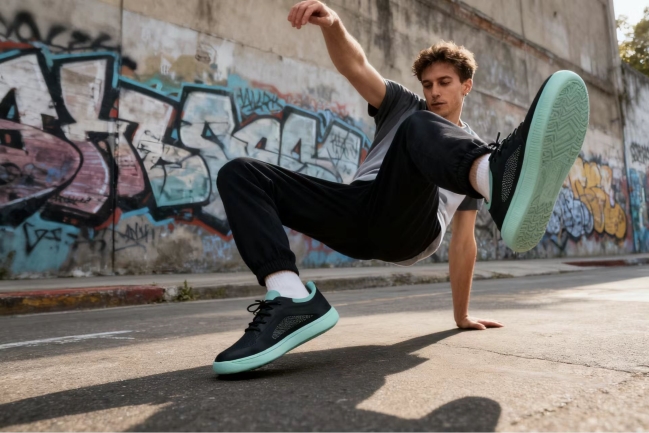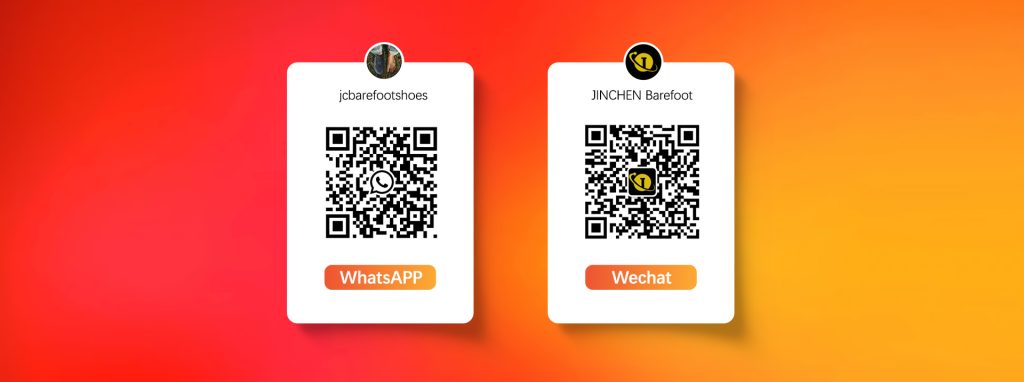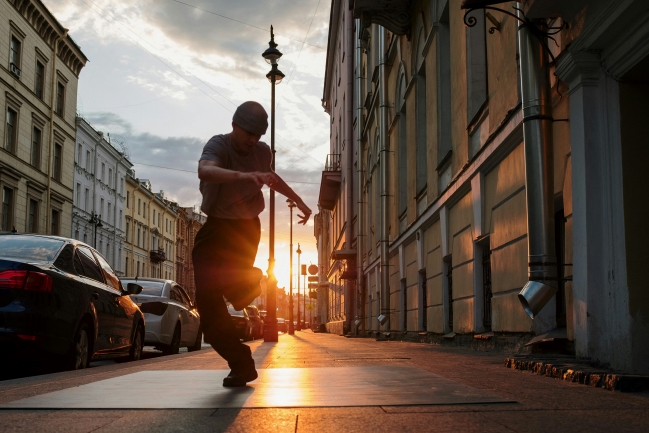Street dance is a form of dance that originates from the streets and integrates music, rhythm and body language. It is not only a performing art, but also a form of self-expression and cultural transmission. Whether it is Breaking (floor moves), Popping (mechanical dance), Locking (lock dance) or Hip-Hop freestyle (hip-hop free dance), the essence of street dance is inseparable from the control of the body, the perception of rhythm and the interaction with the ground.
In recent years, the rise of barefoot shoes has brought new thoughts to street dancers. Unlike the heavy cushioning and wrapping of traditional sports shoes, barefoot shoes emphasize zero drop, wide toe, lightweight and ground feedback, allowing dancers to more directly feel the details of the movements and the changes in the center of gravity.
The Relationship Between Street Dance and the Feet: The Body’s Foundation
The Foot as the Source of Power and Rhythm
Street dance is deeply grounded—literally. Unlike ballet or ballroom, it often relies on friction, weight shifts, and explosive movements against the floor. For example:
In Breaking, moves like Windmill or Flare require strong and stable foot anchoring.
In Popping, stomps and “hitting the beat” often depend on precise heel and toe strikes.
If the feet lack stability or strength, the dancer’s moves feel less grounded and the rhythm less powerful. As many seasoned dancers say: “Strength starts from the ground up.”
The Limitations of Thick-Sole Shoes
Most traditional street dance shoes—skate shoes, basketball sneakers, or casual trainers—are designed with thick midsoles and heavy cushioning. While they protect the feet, they also dull ground feedback. This can reduce the precision of “footwork” and make rhythm less sharp.
For this reason, many dancers even practice barefoot, especially during foundational training, to better feel their body mechanics and weight shifts.
Features of Barefoot Shoes That Fit Street Dance
Zero Drop: Natural Balance
The design core of barefoot shoes is Zero Drop, that is, the heel and the toe are at the same height. This design enables dancers to get closer to a barefoot state and maintain the natural distribution of their body’s center of gravity.
In street dance, dancers need to frequently squat, bounce, spin and burst. Zero drop can help them quickly find balance and avoid over-reliance on the support of the heel.
Wide Toe Box: Unleashing Grip and Control
In street dance moves, the toes often serve the functions of “grasping the ground” and “controlling points”. The wide toe design of barefoot shoes allows the toes to spread naturally, enhancing friction and support.
In the “Freeze” movement of Breaking, the tension of the toes can help the body maintain balance.
In Popping, the flexibility of the toes makes the “ground touch” more explosive.
Thin Soles and Ground Feedback: Precision in Every Step
The soles of barefoot shoes are usually between 3 and 6 millimeters thick, soft and flexible. This enables dancers to clearly perceive the texture, friction and hardness of the ground.
When practicing foot combinations, barefoot shoes can help dancers correct their movements more quickly.
In floor movements, dancers can determine whether the landing point is correct through the feedback of the nerves in the soles of their feet.
Lightweight Design: Reducing Fatigue
Street dance is a high-intensity full-body exercise. Barefoot shoes are often more than half the weight of traditional sports shoes, which means that dancers can perform jumps, spins and steps more lightly, reducing the pressure on their calves and knees.
Why Street Dancers Should Try Barefoot Shoes
Enhanced Body Awareness
Street dance thrives on musicality and body awareness. Barefoot shoes amplify sensory input from the feet, deepening the connection between music, rhythm, and movement.
Improved Foot and Lower Limb Health
Long-term use of cushioned sneakers can weaken arches and toe strength. Since street dance requires strong, stable feet, barefoot shoes can restore arch strength, activate intrinsic foot muscles, and build resilience.
Greater Stability and Control
For spins, slides, and freezes, stability is everything. The low-profile soles of barefoot shoes help dancers avoid slipping and keep their center of gravity under control.
Shared Philosophy with Street Dance
Street dance emerged from the streets as an expression of freedom, authenticity, and raw connection. Barefoot shoes share this philosophy—returning the body to its natural state and freeing human potential.
Both represent a philosophy that is simple yet not simplistic – by eliminating unnecessary embellishments and complexities, returning to the essence. Just as street dance creates infinite possibilities with the most basic body movements, barefoot shoes support the most complex dance language with the simplest design.
This fit is also reflected in the respect for individual differences. Barefoot shoes allow everyone’s feet to function in their natural form, just as street dance encourages each dancer to develop a unique style rather than follow a fixed pattern.

Application of Barefoot Shoes Across Different Street Dance Styles
Breaking
Advantages of barefoot shoes: Lightweight + strong ground perception, making dancers more stable when doing spins and freezes.
Note: Some floor movements require friction from the soles of shoes. It is recommended to choose barefoot shoes with wear-resistant rubber soles.
Popping
Advantages of barefoot shoes: Precise “timing” sensation and enhanced explosive power of “vibration”.
Note: Shoes with overly thin soles may cause too much vibration on hard surfaces. You can choose slightly thick-soled styles.
Locking
Advantages of barefoot shoes: They are more flexible when switching feet quickly, and the wide toe box prevents the toes from being squeezed.
Note: Make sure the soles of your shoes have sufficient grip to avoid slipping.
Hip-Hop Freestyle
The advantages of barefoot shoes: They are light on the feet and offer high freedom of movement, which is in line with the spirit of “free expression” in street dance.
Note: If you dance on the outdoor street ground, you need to consider the wear resistance of the soles of your shoes.
Practical Tips for Dancers Choosing Barefoot Shoes
Choose the right venue: Barefoot shoes are best experienced on wooden floors, dance studios, and smooth cement floors. If training on a rough surface, attention should be paid to the wear resistance of the soles of shoes.
Gradual progress: For dancers who wear thick-soled shoes for a long time, it is recommended to start with partial training and gradually adapt to barefoot shoes.
Combining foot training, such as toe-grasping towels and single-foot balance training, can accelerate the adaptation of foot muscles.
Choose the sole thickness according to the dance style: Breaking is suitable for wear-resistant styles, Popping is suitable for thin-soled styles, and Freestyle is suitable for lightweight and flexible styles.
Pay attention to protection: At the beginning, barefoot shoes may make the soles of your feet more sensitive, so avoid overtraining.
Future Trends: Barefoot Shoes in Street Dance Culture
As street dance enters the lives of more young people, dancers’ demands for shoes are no longer merely about “good looks” and “cushioning”, but they pay more attention to functionality and body perception. The concept of barefoot shoes precisely aligns with the concepts of “authenticity” and “freedom” in street dance culture.
In the future, barefoot shoes might become a new trend in street dance training:
Professional dancers will use barefoot shoes as training shoes to enhance ground perception.
Street dance studios may recommend barefoot shoes as entry-level practice shoes.
Barefoot shoe brands can also join hands with street dance communities to jointly promote the concept of “natural dance”.
As street dance has become an Olympic event, the scientific nature of its training and performance has been increasingly valued. Barefoot shoes, as an ergonomic footwear choice, are expected to play a greater role in the professionalization process of street dance.
Conclusion
Street dance is not just choreography—it is attitude and freedom. It belongs to the streets, to self-expression, to authenticity. Barefoot shoes, too, stand for natural motion, reconnecting the body, and unlocking human potential.
When dancers wear barefoot shoes, they gain more than just lightness and comfort. They rediscover rhythm through their soles, connect deeper with music, and achieve a truer expression of movement.
Next time you see a dancer move freely on the street, take a closer look: those lightweight, flexible shoes might just be barefoot shoes.
If you’re a dancer, try performing in barefoot shoes at least once—you might uncover a whole new layer of rhythm and freedom.
📩 Contact Us
Interested in exploring barefoot shoes for your dance practice? Reach out to us—we’d love to help you find the perfect pair and support your journey into natural movement and street culture.




